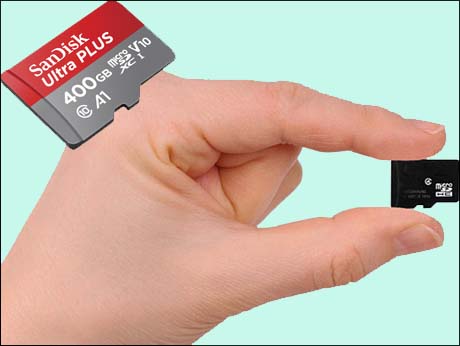
The SD card is now the world's most widely-used portable storage -- with capacity poised to touch a terabyte
Bangalore, November 20, 2017: In 2000, the world's first portable memory card was launched. The standard for what became the SD or Secure Digital card, was a joint development of Panasonic, SanDisk and Toshiba. The first few cards had capacities up to 64 MB. In the 17 years since then, capacity has increased almost 17,000 times: A year ago, SanDisk showed a prototype of the world's first 1 terabyte SD card, the stamp-sized storage that digital cameras use. It is not yet commercially launched, but data-hungry recording formats like 4K and 8K and 360-degree wide, have already created a market for such jumbo storage.
The younger brother of the SD card is the microSD -- the tiny, SIM-sized chips, we slip into mobile phones, to extend their on-board storage. In September this year, Western Digital, now the parent company of SanDisk, offered the highest capacity microSD card -- 400 GB. It could hold 40 hours of full HD video and transfer it at around 100 MBPS. Such big capacities don't come cheap: it costs $ 250 ( Rs 16,500) -- possibly more than the price of the phone itself! But then you pay for the portability, not just capacity. The advantage is, you can seamlessly use such cards as extensions of the native storage on the phone -- thanks to tweaks that come with
In fact, the microSD card is edging out the full-sized SD card in some cameras, like the bike or head-mounted action cameras and as on-board storage for drone cameras. Tiny computers, like that students' favourite, the Rasberry Pi, have also updated their specifications to work with microSDs.
What happens when you build a WiFi antenna into an SD card? You transmit the photos and videos captured by your digital camera, wirelessly to a browser or email, without going through a PC or laptop. The technology is now offered by SD cards like Eye-Fi, Toshiba FlashAir, Transcend WiFi etc. And in yet another nudge towards the future, SD cards have merged with USB. You can plug the SanDisk SD Plus into a USB port by swinging open a hinge that reveals a USB adapter.
The largely consumer-focused SD card and its micro avatar, are slowly finding corporate use as well. Vivek Tyagi, who leads Sandisk's enterprise business in India, says almost a third of the business is now from enterprises. We are only a few years away from a 1TB microSD card, he feels.
They used to say : "You can never have too much storage in the kitchen". Likewise, for SD storage, it seems!